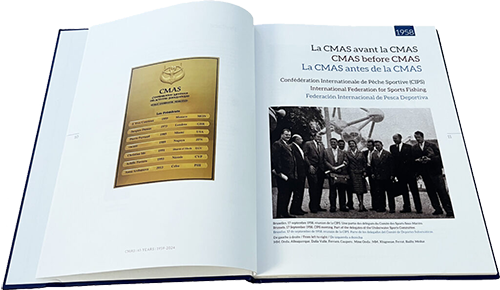Finswimming Fun Facts / History
Leonardo da Vinci designed a webbed glove aimed at improving the efficiency of swimming.
Benjamin Franklin invented the swimming paddles.
He experimented also with wooden boards attached to the feet, but concluded that they are not efficient.
They must have looked like the drawing below.
H. Olsen filed a patent for a life preserving and swimming apparatus.
From the description, it was probably adapted to breaststroke swimming.
As reported by his biographer, Y. Clercin, de Corlieu visited Tahiti and observed local fishermen who swam with woven palm leaves attached to their feet.
He experimented with a propulsion system inspired from this, but without success. It was inefficient because of the discontinuous movement of the breaststroke style swimming.
De Corlieu concluded that the movement must be continuous, adapted to a crawl-like style.
The first fins were constructed.
They were rigid pallets of rhodoïd attached to the soles of the feet.
They can be seen in the photo on the right, where de Corlieu is equipped with a lifesaving rubber suit of his invention, which he demonstrated in 1927.
Back to France, de Corlieu produced the first rubber fins. They had a metal core in order to ensure rigidity.
He filed a patent for this invention that he named “propulseurs de natation et de sauvetage”.
Aquatic festivals and competitions were organised in Paris, and the “de Corlieu” fins were omnipresent.
Notice in the photo that the propulsive surface of the fin is on top.
The first recorded performance using fins is 59 s for 66 m.
During aquatic “ballets” a monofin made a first appearance. It consisted in two “de Corlieu” fins glued together in the middle.
There is no existing visual record of the first monofin, but we can surmise that it would have looked, more or less.
The person who made the swimming fins known world-wide is an American yachtman (1932 olympic gold medalist), Owen Churchill.
While visiting Tahiti he observed natives from the Marquesas islands who dived with fins made from woven palm leaves. He was interested and did try them.
Then he met H. Lombard who used de Corlieu fins and the latter turned out to be much more efficient. He purchased a pair and, upon returning to the States, he tried to locate the inventor.
According to “scuba legend” Sam Miller III, Churchill met de Corlieu in Morocco (a photo of the two purportedly exists) and purchased the rights of his patent for the US. He named the product “swim fins”.
He changed the shape, eliminated the metal core and started producing them industrially.
During WWII Churchill equipped the US Underwater Demolition Team (they were later renamed to Navy Seals) with his swim fins. The english frogmen adopted the same fins. (The anecdote is that the first shipping of swim fins to England was lost when the ship sank, having been torpedoed by a German submarine).
It appeared soon that the Churchill swim fins were not quite up to the task for the Demolition Team members and so the Navy contracted another rubber sporting-goods manufacturer to develop new fins. In 1944 the Voit Duckfeet fins were introduced.
Their design was slightly modified after the war and they became the standard fins for bodysurfing.
While de Corlieu and Churchill made essential contributions, the person without whom fisnwimming wouldn’t have existed is Luigi Ferraro. He was a war veteran, having served in the X-MAS, the famous “decima Flottiglia” of Italian frogmen.
After the war Ferraro interested himself in underwater activities and in particular finswimming from a pure sports point of view.
The first difficulty was that of equipment. The fins used during the war, produced by Superga, were definitely not adapted to civilian use.
Thus Ferraro set out to design and produce a new type of fins in 1950. The “Rondine” were the first fins to include all foot while leaving toes free.
Ferraro started organising competitions where the swimmers were equipped with fins. Finswimming was born. The first such competition took place in 1951. It was off the cost of Genova from Lido to Nervi in four stages. In the photo we see the participants swimming without snorkel (although the lady on the left holds one in her right hand).
Ferraro went on to organise, in 1955, the “100 km along the Adriatic Sea”, between Rimini and Ancona. Then, in 1960 the first international competition took place in Palermo (under the presumptive name of “world championship”).
Meanwhile, national championships were being organised, in Soviet Union (1958), France and Italy (1961).
Commander J.Y. Cousteau was elected president.
L. Ferraro became president of the Sports Committee.
In order to improve their performances, the athletes started using longer and longer fins. The fins “Sadala Gigant”, 63 cm long, were produced in Bulgaria. They met with great success in competition.
B. Popov, not disposing of Gigant, had the idea to lengthen and strengthen “normal” fins with metal strips covered with rubber.
First European Championships of Finswimming and Underwater Techniques (SCUBA immersion and Orienteering) in Angera, Italy.
S. Tarasov won the 40 m apnea in 18.3 s (with Gigant fins).
The Novosibirsk team improved the design of Popov using titanium instead of bronze resulting in lighter fins.
The second European Championships were held in Aliushta, USSR. The bad weather made it impossible to hold all events in open water.
Some events were held in swimmingpool and this led to a separation of finswimming and orienteering.
The first fins with titanium strips made their appearance in competition.
The Tomsk team, Zhdanov, Schumkov and Titov, introduced fiberglass, leading to even lighter fins.
Promoting responsibility among fellow divers can enhance adherence to sustainable practices that we advocate. Divers are encouraged to urge their diving companions to adopt the same sustainability efforts that we promote so as to minimize the impact on the underwater environment.
The monofin story
The monofin is what gave to our sport its distinctive identity.
An Austrian UW photographer, K. Schaefer, constructed the first monofin using two de Corlieu fins with a semi-rigid separator in the middle, ensuring the correct spacing of the feet.
K. Ristau and H.J. Bergann, founders of Barakuda, filed, in 1955, for a patent (awarded in 1961) of a monofin (never produced).
J. Chrstiansen filed for a patent for a device allowing two fins to be attached, forming a monofin. The patent, awarded in 1965, did not lead to a production of a monofin.
E. Reckson glued the rubber part of the fins together, leaving the rest free. While his athlete O. Tikhonenko had some success with these fins, the gain in velocity was very small.
The same year B. Porotov made a high-speed, 80 cm long, monofin, by stretching a sheet of rubber over a titanium alloy frame. His swimmer, N. Turukalo, broke world records in underwater events already in 1969. Porotov was convinced that the monofin was not adapted to surface swimming. But when Turukalo forgot her bi-fins at the hotel, he let her swim the 100 m SF with the monofin and Turukalo improved the world record by more than 2 seconds!
F. Pavone, a colleague of L. Ferraro in the X-MAS and founder of Sub-Bologna (the first Italian finswimming club) constructed a monofin, by attaching two fins together. He named it “matrimoniale”.
At the 4th European Championships in Sabadell, Spain, Turukalo, won 100 m SF, 25 m AP and 100 m IS, the latter with a 10 s advance over the silver medalist.
The use of 1971 fiberglass monofins was generalised. During the European championships in Avignon, France, A. Salmin, swimming with a fiberglass monofin (photo left, held by an unknown girl), improved the world record of the 40 m apnea with 14.1 s.
The 6th European Championships were held in Moscow. V. Kon swam the full length of the 100 m SF underwater in 39.92 seconds!
During the same championships the men’s apnea event became a 50 m with start from the block. It was won by S. Karapetian in 17.4 s.
By 1971 swimmers of immersion events started diving from the blocks. The first reaction was to forbid this. But then, one year later, the sensible decision was taken: diving from the blocks was authorised.
In fact, swimmers participating in the 40 m apnea also dived from the block preferring to swim 50 m but arriving at the 40 m line at full speed. Following this, the apnea event became a 50 m one starting from 1972.
While the men’s apnea event became a 50 m, the women had to wait till 1976 for “graduating” to the 50 m. Those were times when women were still considered weaker than men.
Fortunately things have changed.
Following V. Kon’s feat of swimming underwater (in apnea) a full 100 m it was decided, for safety reasons, to limit the apnea in surface events to 15 m per swimming-pool length (at the start and at each turn). At the same time neoprene suits were forbidden for swimming-pool events.
As a consequence of all these, radical, rules’ changes it was decided to make a tabula rasa of existing records. Thus CMAS records (world and continental) started being officially recognised from 1974.
The first World Finswimming championships were organised in Hannover in 1976. Thirteen countries did participate, all of them representing Europe. V. Souchkov was the first swimmer under 17 s in the 50 m apnea with a world record of 16.92 s.
A new rule was introduced on this occasion concerning the surface events. Swimmers in monofin, obliged up to that time to use their arms as in crawl style, could from then on have only one arm cycle per swimming-pool length. Fortunately the obligation of arm cycle, which created problems for both swimmers and judges, was abandoned the very next year.
The second world championship was held in Bologna with 16 countries present, but again only European ones did participate.
Things were going to change from 1982. Mexico was the first team outside Europe to participate in a World Championship.
Finswimming was invited to participate in the first World Games which were held in Santa Clara (US) in 1981.
The World Games are global competitions for sports which are not yet part of the Olympic Games. Finswimming has been in the program of the World Games from the outset, being a discipline of Underwater Sports represented by CMAS.
The first European Junior Championships were organised in 1984. They were followed by World Championships in 1989.
The major recognition for CMAS and Finswimming arrived in 1986. During the 91st session of the International Olympic Committee it was decided to officially recognise CMAS. This was the first, necessary, (but, unfortunately, not sufficient) step towards the inclusion of the “underwater sports” in the olympic program.
Following a first European Open Water championship organised in 1987, the first World Open Water Championship took place in Paris in 1988. In the photo (left) on can see the swimmers in the Seine river, swimming towards the Concorde bridge.
The first Asian Finswimming championship was organised in Tokai, Japan.
The fifth World Championship was held in Rome in 1990. It was a huge success with 38 countries participating.
Several new countries were present at the championship, including Cyprus, Israel, Great Britain, Malta, Hong Kong, Taiwan, Chile and Australia.
Following a first European Open Water championship organised in 1987, the first World Open Water Championship took place in Paris in 1988. In the photo (left) on can see the swimmers in the Seine river, swimming towards the Concorde bridge.
The 50 m surface event was added to the program of Finswimming championships and the 800 m immersion was added to women’s program.
The first Panamerican Championship was organised in Bogotá, Colombia.
The seventh World Championship was organised in Dong Guan, China in 1994. Twenty five countries were present at this championship representing four continents.
For the first time in CMAS history the World Championships crossed the Atlantic with the swimming-pool one organised in Cali (1998) and the Open Water in San Andrés (1999), both in Colombia.
The Cali championship was a great success: 25 countries participating, with Argentina, New Zealand and Uruguay making their first appearance. In San Andrés, Perú had its first participation in a World Championship.
That was the year when E. Andronov revolutionised Finswimming with the new design of a monofin. He proposed a design incorporating two of the previous proposals of the Tomsk team, namely the pronounced angle between the foot and the blade as well as the lateral “wings”, complementing them by long rubber overshoes.
This new monofin allowed an explosion of records, leading to a gain of several seconds per 100 m.
In 2003 Finswimming visited a new continent, Africa, for the World Open Water championship.
Several new countries were present at the championship, including Tunisia, Algeria, Palestine, Lebanon and Syria.
In 2006, CMAS took the ground-breaking decision to introduce events for bifins in competition. At first, the distances of 50, 100 and 200 m were included in the CMAS championships, soon to be followed by the 400 m.
In 2007 were organised in Bari the first CMAS Games, a multi-sport competition bringing together all CMAS disciplines. For finswimming that was a World.
The first Masters’ World Cup took place in 2014 in Ravenna. It was to be followed by several more over the next years, held in Europe and in America.
Finswimming was part of the Mediterranean Beach Games, a first step towards the recognition of CMAS by the Mediterranean Games Committee.
The first Masters’ World Championship was organised in Ravenna with swimmingpool and Open Water events.
Starting from 2021 the latter would join a championship rallying junior, senior and master in one venue.
CMAS was officially recognised by the Federation Internationale de Sport Universitaire.
CMAS became officially a member of the Mediterranean Games, participating with Finswimming in the core program of the traditional Mediterranean Games starting with the 2026 edition in Taranto. Furthermore, Finswimming events in open water will be included in the sports program of the Mediterranean Beach Games.




























